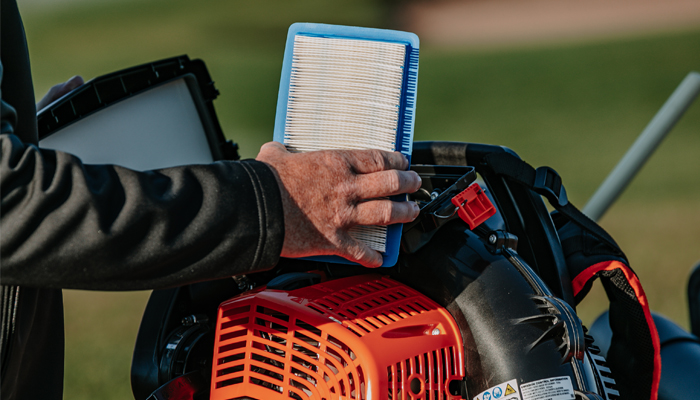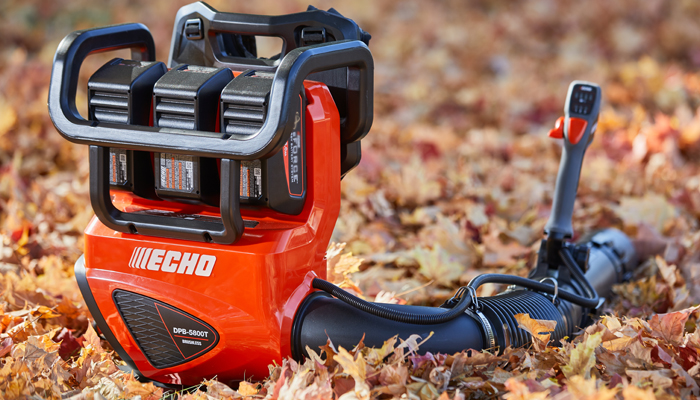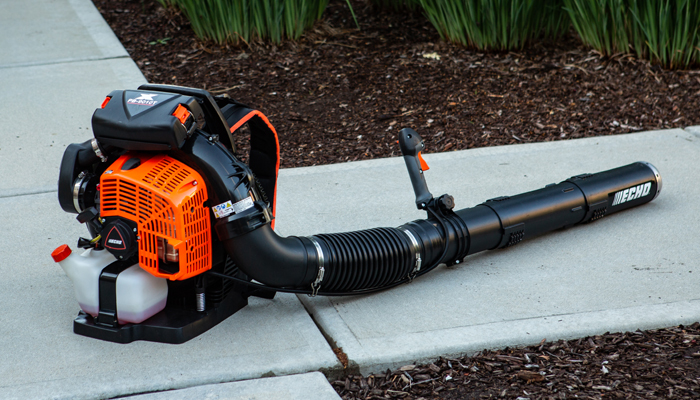Leaf Blower Maintenance
As the seasons change and you’re getting ready to do some basic yard clean-up, a leaf blower can be a game changer that makes jobs hassle-free and easy. If you’ve recently bought a leaf blower or you’re ready to break out your old one for the season, don’t forget how important regular leaf blower maintenance is.
Taking proper care of your blower ensures your tool will stay in top shape for years, improving performance and extending lifespan. Get essential tips here – from learning how to clean a blower, to what proper battery care entails, to finding out where and how to store a leaf blower – we’re covering it all.
Routine Inspection and Cleaning
Whether you have a handheld or backpack-style blower, or a gas or battery-powered blower, regular inspection and cleaning means you’ll get optimal performance with every use. It doesn’t take long, and it pays off when your blower offers powerful airflow every time you fire it up.
Inspecting the air filter, cooling systems, choke shutter, and fuel system is a simple but effective way to lengthen the life of your tool.
Air Intake and Filter - Gas Blowers
Air intake plays a pivotal role in maximizing efficient leaf blower performance. It allows optimal airflow during use, and a filter prevents dirt and debris from entering the engine. Learning to care for and replace the air filter on your blower means you get clean air intake for power with every use.

Tips on inspecting and maintaining your leaf blower’s air intake and filter:
- Remove the filter cover.
- Find the filter and remove it.
- Inspect for dirt, debris, or oil residue.
- If the filter is damaged or dirty and needs more than just simple cleaning, it might be time to replace it.
- Wash the filter with a mild detergent – regular dish soap and warm water is perfect.
- Rinse the filter and squeeze to remove any water.
- Allow the filter to dry before placing it back in the blower.
Cooling System - Gas Blowers
While leaf blowers typically have cooling systems, the complexity and design can widely vary depending on your blower type and model.
Gas-powered leaf blowers typically use air-cooled engines to dissipate heat during operation.
Battery-powered leaf blowers do not have a cooling system like gas blowers do since they generate less heat and don’t need the same level of active cooling. However, they still rely on adequate airflow, so they likely have some features that facilitate air flow around the unit to prevent overheating.
Tips on inspecting and maintaining your leaf blower cooling system:
- Check all air vents – Intake and exhaust – for obstruction, dirt, debris, or clippings.
- Inspect cooling fins – If your leaf blower has this feature, look for damage, bending, debris, or dirt buildup. If bent, straighten carefully.
- Clean the cooling fan – Make sure air circulates around the engine to prevent overheating.
Inspect and Tighten Screws, Nuts and Bolts - All Blowers
A simple but critical part of blower maintenance is regularly inspecting and tightening any screws, nuts, or bolts to make sure structural integrity remains intact. This can also prevent safety hazards – loose or missing fasteners can create safety risks, including parts coming loose detaching unexpectedly during operation.
The practice also helps avoid damage from engine vibration, which can cause screws, nuts, and bolts to loosen over time. Periodically checking that all fasteners are tightened will keep the operator safe and help extend the lifespan of your blower.
Tips for inspecting and tightening screws, nuts, and bolts:
- Visually inspect the exterior of your leaf blower.
- Pay attention to critical components, like handles, guards, engine mounts, and housing covers, which are prone to loosening.
- Use the right tools for the job – you might need a screwdriver, wrench, or socket set to tighten the components of your blower adequately.
- Always tighten to specifications as given in the unit’s manual.
- Replace missing or damaged screws or bolts as soon as you find them.
Battery Maintenance - Battery-Powered Blowers
Rechargeable battery-powered leaf blowers require battery care to guarantee longevity and operable performance. Simple maintenance goes a long way in stretching the life of your battery as long as possible before it needs to be replaced.
Tips for charging and maintaining your leaf blower battery:
Charging best practices:
- Always use ECHO batteries with ECHO chargers. Using chargers from other manufacturers can damage the battery or drastically reduce how long it lasts. Check out ECHO Battery Systems for all your battery and charging needs.
- Unplug the charger when charging is complete.
- Charge your leaf blower battery at moderate temperatures.
Battery care:
- Make sure the battery terminals are clean and free from dust or corrosion. Use a soft, dry cloth to gently wipe the terminals, and avoid harsh chemicals that can damage the battery.
- Don’t over-drain the battery. The best practice is to recharge it when it has about 20 to 30% capacity remaining.
- Regular use of your leaf blower will help prevent the battery from sitting, ultimately allowing it to maintain capacity and prevent it from losing its charge-holding ability.

Choke Shutter - Gas-Powered Blowers
A choke, or choke shutter, is generally found in gas-powered leaf blowers. Used to control the air-fuel mixture during engine startup, chokes restrict airflow into the carburetor to make cold starts easier. Battery powered leaf blowers don’t need a choke as they don’t have combustion engines.
Tips on inspecting and cleaning the choke shutter on a leaf blower:
- Turn off the leaf blower
- To locate the choke shutter, look near the carburetor or air intake.
- Check the choke for dirt, debris, or buildup.
- Clean the choke and surrounding area with a soft brush or compressed air.
- Carefully open and close the choke shutter to check that it moves freely.
Fuel System
A leaf blower’s fuel system delivers the right fuel-air mixture to the engine for smooth operation and performance. Regular fuel system inspection is essential to avoid starting issues and offer reliable operation. The following simple, regular maintenance tips will keep your leaf blower running smoothly, so you can easily tackle every job.
Tips on inspecting and maintaining your leaf blower’s fuel system:
- Check the fuel lines – Look for cracks, leaks, or signs of excessive wear. Replace any damaged lines to prevent leaks that can cause starting issues or safety hazards.
- Inspect the fuel filter – It’s located inside the fuel tank. Look for clogs or debris buildup that might restrict fuel flow and impede operation. Replace the filter as needed.
- To clean the fuel tank – Remove the cap and look for sediment, dirt, or debris inside the tank. Cleaning the full fuel tank is easy with a mixture of soap and water or a fuel tank cleaning product. Rinse the tank thoroughly and allow it to dry completely before refilling with new fuel.
- Check your fuel quality – Always use fresh, clean gasoline – ECHO’s Red Armor® Fuel is the perfect fuel solution.
- Check the carburetor - Check the carburetor for signs of damage, or corrosion. Clean thoroughly with carburetor cleaner and a soft brush to prevent fuel flow issues.
Ready to work on one of your Echo power tools? Check out our ECHO YOUCAN™ maintenance kits for all your repair needs.
Safety Measures During Maintenance
Anytime you’re cleaning your tool or performing blower maintenance, practicing safety measures is essential to prevent accidents and injuries.
Safety gear:
- Eye protection – Safety goggles or glasses protect your eyes during maintenance tasks.
- Ear protection – Wearing earplugs or earmuffs can protect your hearing.
- Hand protection – Heavy-duty gloves will shield your hands from hot surfaces, chemicals, or sharp edges.
- Respiratory protection – If you’re working in a dusty or confined space, wearing a dust mask or respirator protects you from inhaling fumes or harmful particles.
Handling and storing fuel and lubricants:
- Handling – Always use extreme caution when handling gasoline or any type of fuel. Never smoke or have an open flame in the area. Refueling any gas-powered tool should be done in an outdoor or well-ventilated area.
- Storage – Only store fuel in an approved container designed for flammable liquid storage. Keep containers tightly sealed and away from all heat sources, sparks, or flames.
- Lubricant – When applying oil or lubricants, be sure the engine or power sources are turned off and cooled down.
- Disposal – Always dispose of any used fuel, lubricant, or chemical according to local regulations and recommendations.
How To Store a Leaf Blower
Between uses – and especially when the season ends – proper leaf blower storage is vital and will keep your tool in excellent condition so it’s ready for the next job. But before storing a leaf blower for the off-season, make sure you follow these tips:
- Clean your blower – Thoroughly clean your leaf blower, paying extra attention to the air intake, exhaust, and cooling fins (if you have them).
- Inspect for damage – Check for worn-out parts, loose fasteners, damaged cords, and signs of wear.
- Empty the fuel tank – If you have a gas leaf blower, make sure the tank is empty or that you’ve added a fuel stabilizer.
- Fully charge the battery – Battery-powered blowers should be charged before storing.
- Store in a dry area – Store your blower in a dry, well-ventilated area, away from sunlight and moisture, to protect it during off months.
- Store accessories – If your blower has attachments or accessories, keep them together in a designated area so they’re easy to find and ready to use next season.

Get the Most Out of Your Leaf Blower
Leaf blower maintenance isn’t complicated. With the right information, know-how, and a little dedication, you can keep your blower looking and performing like new, with a powerful blowing force that lasts season after season.
Ready to get even more out of your leaf blower? Check out Echo’s line of leaf blower accessories, designed to enhance your blower so it can tackle even the most challenging jobs.